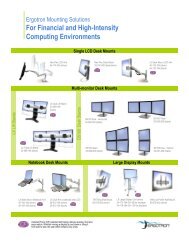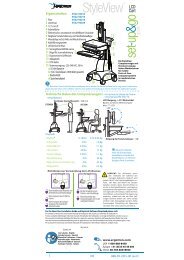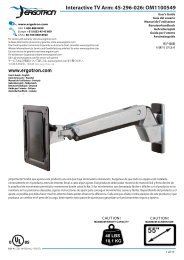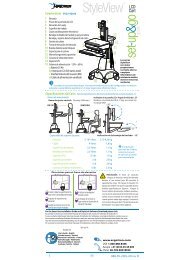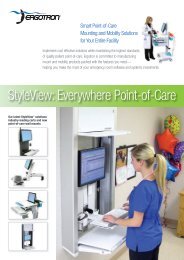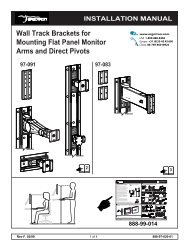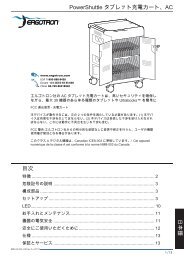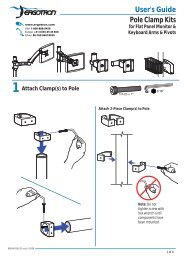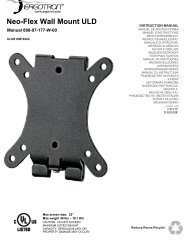ergonomic factors involved in good workstation design - Ergotron
ergonomic factors involved in good workstation design - Ergotron
ergonomic factors involved in good workstation design - Ergotron
Create successful ePaper yourself
Turn your PDF publications into a flip-book with our unique Google optimized e-Paper software.
ERGONOMIC FACTORS INVOLVED IN<br />
OPTIMUM COMPUTER WORKSTATION DESIGN<br />
A PRAGMATIC APPROACH<br />
Ergonomics: Application of scientific knowledge to the work place <strong>in</strong> an effort to improve the<br />
well be<strong>in</strong>g and efficiency of workers.<br />
Background<br />
“The future…depends on how we develop human <strong>in</strong>terfaces that create a<br />
match between the <strong>in</strong>ternal rhythms of the operator and the computer.”<br />
– Dr. Joel Orr, Computer Graphics Consultant –<br />
Over the past several years numerous scientific papers have been written on the <strong>ergonomic</strong><br />
<strong>factors</strong> <strong><strong>in</strong>volved</strong> <strong>in</strong> computer <strong>workstation</strong> <strong>design</strong>. This paper will not attempt to duplicate the<br />
large base of scientific knowledge and the many <strong>ergonomic</strong> studies already well documented.<br />
The goal of this paper is to offer a practical guide to <strong>in</strong>terpret<strong>in</strong>g published <strong>ergonomic</strong> guidel<strong>in</strong>es<br />
and the anthropometric data that can be used to create a user friendly, <strong>ergonomic</strong>ally correct<br />
computer work environment.<br />
Many <strong>factors</strong> are <strong><strong>in</strong>volved</strong> <strong>in</strong> the <strong>design</strong> of a computer <strong>workstation</strong> such as:<br />
• VDT adjustability<br />
• Keyboard placement/adjustability<br />
• Worksurface adjustability<br />
• Chair <strong>design</strong>/adjustability<br />
• Foot rests<br />
• Wrist rests<br />
1<br />
• Glare screens<br />
• Light<strong>in</strong>g, task light<strong>in</strong>g<br />
• Ease of adjustability<br />
• Accessibility to components<br />
• Human Computer Interfaces (HCI’s)<br />
• Space sav<strong>in</strong>gs<br />
All of the above issues concern themselves with the reduction or elim<strong>in</strong>ation of a class of<br />
physical disorders associated with poor <strong>ergonomic</strong> <strong>design</strong> known as Musculoskeletal Stress<br />
Disorders (MSD’s), which result <strong>in</strong>:<br />
• Eye, neck and back stra<strong>in</strong><br />
• Fatigue, headache<br />
• Wrist, hand, elbow and shoulder diseases<br />
Carpal Tunnel Syndrome<br />
Tenosynovitis<br />
Tendonitis<br />
Synovitis<br />
Some of the primary causes of eye, neck and back stra<strong>in</strong>, which cause visual problems and<br />
wrist, hand, elbow and shoulder diseases are:<br />
• Improper VDT screen height and the <strong>in</strong>ability to adjust the screen height to <strong>in</strong>dividual<br />
preferences<br />
• Improper VDT view<strong>in</strong>g distance and the <strong>in</strong>ability to adjust the same



